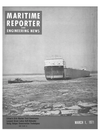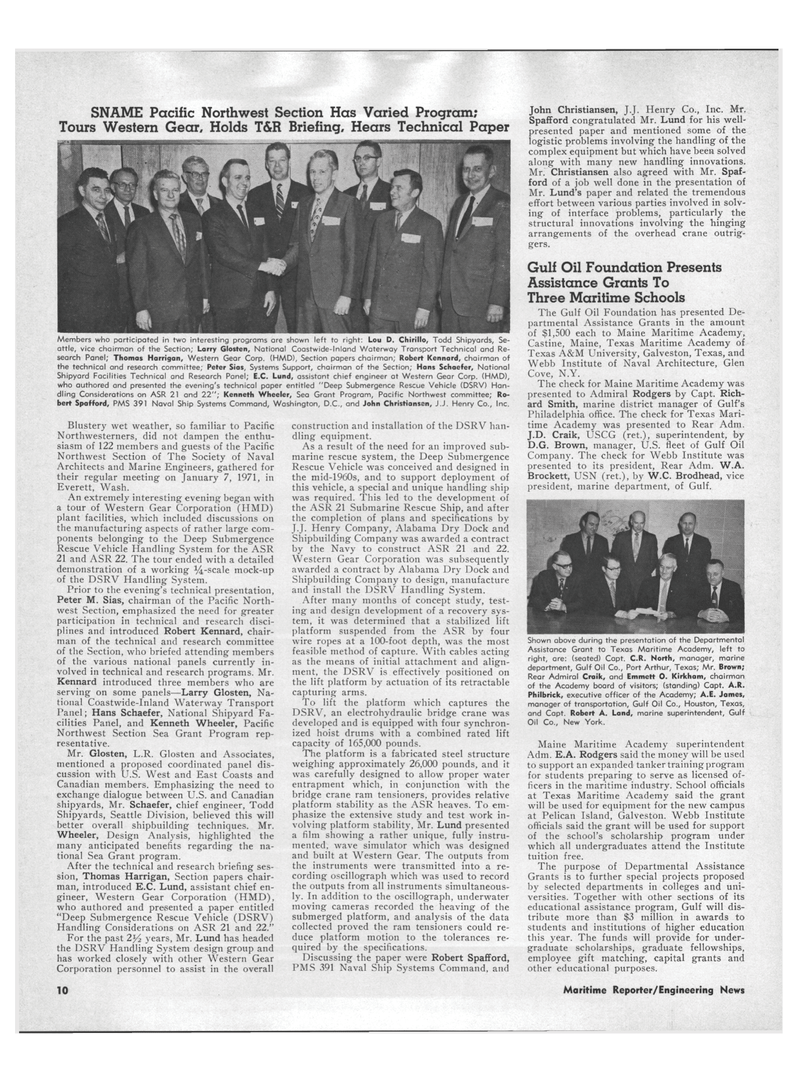
Page 8: of Maritime Reporter Magazine (March 1971)
Read this page in Pdf, Flash or Html5 edition of March 1971 Maritime Reporter Magazine
SNAME Pacific Northwest Section Has Varied Program;
Tours Western Gear, Holds T&R Briefing, Hears Technical Paper
Members who participated in two interesting programs are shown left to right: Lou D. Chirillo, Todd Shipyards, Se- attle, vice chairman of the Section; Larry Glosten, National Coastwide-lnland Waterway Transport Technical and Re- search Panel; Thomas Harrigan, Western Gear Corp. (HMD), Section papers chairman; Robert Kennard, chairman of the technical and research committee; Peter Sias, Systems Support, chairman of the Section; Hans Schaefer, National
Shipyard Facilities Technical and Research Panel; E.C. Lund, assistant chief engineer at Western Gear Corp. (HMD), who authored and presented the evening's technical paper entitled "Deep Submergence Rescue Vehicle (DSRV) Han- dling Considerations on ASR 21 and 22"; Kenneth Wheeler, Sea Grant Program, Pacific Northwest committee; Ro- bert Spafford, PMS 391 Naval Ship Systems Command, Washington, D.C., and John Christiansen, J.J. Henry Co., Inc.
Blustery wet weather, so familiar to Pacific
Northwesterners, did not dampen the enthu- siasm of 122 members and guests of the Pacific
Northwest Section of The Society of Naval
Architects and Marine Engineers, gathered for their regular meeting on January 7, 1971, in
Everett, Wash.
An extremely interesting evening began with a tour of Western Gear Corporation (HMD) plant facilities, which included discussions on the manufacturing aspects of rather large com- ponents belonging to the Deep Submergence
Rescue Vehicle Handling System for the ASR 21 and ASR 22. The tour ended with a detailed demonstration of a working ^-scale mock-up of the DSRV Handling System.
Prior to the evening's technical presentation,
Peter M. Sias, chairman of the Pacific North- west Section, emphasized the need for greater participation in technical and research disci- plines and introduced Robert Kennard, chair- man of the technical and research committee of the Section, who briefed attending members of the various national panels currently in- volved in technical and research programs. Mr.
Kennard introduced three members who are serving on some panels—Larry Glosten, Na- tional Coastwide-lnland Waterway Transport
Panel; Hans Schaefer, National Shipyard Fa- cilities Panel, and Kenneth Wheeler, Pacific
Northwest Section Sea Grant Program rep- resentative.
Mr. Glosten, L.R. Glosten and Associates, mentioned a proposed coordinated panel dis- cussion with U.S. West and East Coasts and
Canadian members. Emphasizing the need to exchange dialogue between U.S. and Canadian shipyards, Mr. Schaefer, chief engineer, Todd
Shipyards, Seattle Division, believed this will better overall shipbuilding techniques. Mr.
Wheeler, Design Analysis, highlighted the many anticipated benefits regarding the na- tional Sea Grant program.
After the technical and research briefing ses- sion, Thomas Harrigan, Section papers chair- man, introduced E.C. Lund, assistant chief en- gineer, Western Gear Corporation (HMD), who authored and presented a paper entitled "Deep Submergence Rescue Vehicle (DSRV)
Handling Considerations on ASR 21 and 22."
For the past 2years, Mr. Lund has headed the DSRV Handling System design group and has worked closely with other Western Gear
Corporation personnel to assist in the overall construction and installation of the DSRV han- dling equipment.
As a result of the need for an improved sub- marine rescue system, the Deep Submergence
Rescue Vehicle was conceived and designed in the mid-1960s, and to support deployment of this vehicle, a special and unique handling ship was required. This led to the development of the ASR 21 Submarine Rescue Ship, and after the completion of plans and specifications by
J.J. Henry Company, Alabama Dry Dock and
Shipbuilding Company was awarded a contract by the Navy to construct ASR 21 and 22.
Western Gear Corporation was subsequently awarded a contract by Alabama Dry Dock and
Shipbuilding Company to design, manufacture and install the DSRV Handling System.
After many months of concept study, test- ing and design development of a recovery sys- tem, it was determined that a stabilized lift platform suspended from the ASR by four wire ropes at a 100-foot depth, was the most feasible method of capture. With cables acting as the means of initial attachment and align- ment, the DSRV is effectively positioned on the lift platform by actuation of its retractable capturing arms.
To lift the platform which captures the
DSRV, an electrohydraulic bridge crane was developed and is equipped with four synchron- ized hoist drums with a combined rated lift capacity of 165,000 pounds.
The platform is a fabricated steel structure weighing approximately 26,000 pounds, and it was carefully designed to allow proper water entrapment which, in conjunction with the bridge crane ram tensioners, provides relative platform stability as the ASR heaves. To em- phasize the extensive study and test work in- volving platform stability, Mr. Lund presented a film showing a rather unique, fully instru- mented, wave simulator which was designed and built at Western Gear. The outputs from the instruments were transmitted into a re- cording oscillograph which was used to record the outputs from all instruments simultaneous- ly. In addition to the oscillograph, underwater moving cameras recorded the heaving of the submerged platform, and analysis of the data collected proved the ram tensioners could re- duce platform motion to the tolerances re- quired by the specifications.
Discussing the paper were Robert Spafford,
PMS 391 Naval Ship Systems Command, and
John Christiansen, J.J. Henry Co., Inc. Mr.
Spafford congratulated Mr. Lund for his well- presented paper and mentioned some of the logistic problems involving the handling of the complex equipment but which have been solved along with many new handling innovations.
Mr. Christiansen also agreed with Mr. Spaf- ford of a job well done in the presentation of
Mr. Lund's paper and related the tremendous effort between various parties involved in solv- ing of interface problems, particularly the structural innovations involving the hinging arrangements of the overhead crane outrig- gers.
Gulf Oil Foundation Presents
Assistance Grants To
Three Maritime Schools
The Gulf Oil Foundation has presented De- partmental Assistance Grants in the amount of $1,500 each to Maine Maritime Academy,
Castine, Maine, Texas Maritime Academy of
Texas A&M University, Galveston, Texas, and
Webb Institute of Naval Architecture, Glen
Cove, N.Y.
The check for Maine Maritime Academy was presented to Admiral Rodgers by Capt. Rich- ard Smith, marine district manager of Gulf's
Philadelphia office. The check for Texas Mari- time Academy was presented to Rear Adm.
J.D. Craik, USCG (ret.), superintendent, by
D.G. Brown, manager, U.S. fleet of Gulf Oil
Company. The check for Webb Institute was presented to its president, Rear Adm. W.A.
Brockett, USN (ret.), by W.C. Brodhead, vice president, marine department, of Gulf.
Shown above during the presentation of the Departmental
Assistance Grant to Texas Maritime Academy, left to right, are: (seated) Capt. C.R. North, manager, marine department, Gulf Oil Co., Port Arthur, Texas; Mr. Brown;
Rear Admiral Craik, and Emmett O. Kirkham, chairman of the Academy board of visitors; (standing) Capt. A.R.
Philbrick, executive officer of the Academy; A.E. James, manager of transportation, Gulf Oil Co., Houston, Texas, and Capt. Robert A. Land, marine superintendent, Gulf
Oil Co., New York.
Maine Maritime Academy superintendent
Adm. E.A. Rodgers said the money will be used to support an expanded tanker training program for students preparing to serve as licensed of- ficers in the maritime industry. School officials at Texas Maritime Academy said the grant will be used for equipment for the new campus at Pelican Island, Galveston. Webb Institute officials said the grant will be used for support of the school's scholarship program under which all undergraduates attend the Institute tuition free.
The purpose of Departmental Assistance
Grants is to further special projects proposed by selected departments in colleges and uni- versities. Together with other sections of its educational assistance program, Gulf will dis- tribute more than $3 million in awards to students and institutions of higher education this year. The funds will provide for under- graduate scholarships, graduate fellowships, employee gift matching, capital grants and other educational purposes. 10 Maritime Reporter/Engineering News

 7
7

 9
9
